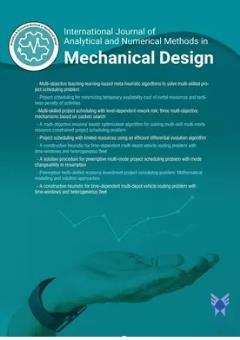Stress Distribution and Relaxation in Cellulose Nanocrystal- Enhanced GFRP Composites Under Sustained Loading
Subject Areas : Analytical and Numerical Methods in Mechanical Design
Ehsan Ataei
1
![]() ,
Yones Mohammadi
2
,
Ali Akbar Pasha Zanoosi
3
,
Yones Mohammadi
2
,
Ali Akbar Pasha Zanoosi
3
1 -
2 -
3 - Faculty of Industrial & Mechanical Engineering,Islamic Azad University, Qazvin Branch,
Qazvin, Iran
Keywords: GFRP Composites, Cellulose Nanocrystals (CNCs), Creep, Stress Relaxation, Finite Element Analysis (FEA), Representative Volume Element (RVE), Norton-Bailey Model, Burgers Model, Micromechanics,
Abstract :
The viscoelastic nature of the polymer matrix in Glass Fiber Reinforced Polymer (GFRP) composites results in complex time-dependent stress redistribution under sustained loads, a critical factor for maintaining long-term structural integrity. This study presents a comprehensive experimental and numerical investigation into the creep behavior and stress relaxation mechanisms of GFRP composites, with a specific focus on the enhancement effects of cellulose nanocrystals (CNCs). The Norton-Bailey creep model was rigorously calibrated for a DGEBA epoxy matrix, demonstrating exceptional predictive accuracy (R² > 0.95) with a creep exponent of n ≈ 1.082. The Burgers model was employed to capture the time-dependent behavior of the fiber-matrix system. Micromechanical analysis via Finite Element Analysis (FEA) of high-fidelity Representative Volume Elements (RVEs) subjected to a sustained equivalent stress of 100 MPa for 7200 seconds revealed profound, orientation-dependent stress evolution. In 0° laminates, fiber stress decreased by 17% while matrix stress increased by 340%, signifying dramatic load transfer. Incorporation of 1.0 wt% CNCs was identified as optimal, reducing stress concentration factors by 17–36% and enhancing stress field homogeneity across all fiber orientations (0°, 45°, 90°) by improving interfacial bonding and matrix stiffness. This validated multi-scale framework provides critical insights and a reliable predictive tool for designing durable, high-performance composite structures in aerospace, automotive, and civil infrastructure applications.
[1]Gibson, R. F. (2016). Principles of Composite Material Mechanics (4th ed.). CRC Press.
[2]Mallick, P. K. (2007). Fiber-Reinforced Composites: Materials, Manufacturing, and Design. CRC Press.
[3]Brinson, L. C., & Brinson, H. F. (2015). Polymer Engineering Science and Viscoelasticity: An Introduction. Springer.
[4]Findley, W. N., Lai, J. S., & Onaran, K. (1976). Creep and Relaxation of Nonlinear Viscoelastic Materials. Dover Publications.
[5]Norton, F. H. (1929). The Creep of Steel at High Temperatures. McGraw-Hill.
[6]Bailey, R. W. (1935). The creep of steel under simple and compound stresses. Journal of the Institute of Fuel, 8, 175-185.
[7]Dufresne, A. (2013). Nanocellulose: From nature to high-performance tailored materials. De Gruyter.
[8]Moon, R. J., Martini, A., Nairn, J., Simonsen, J., & Youngblood, J. (2011). Cellulose nanomaterials review: structure, properties, and nanocomposites. Chemical Society Reviews, 40(7), 3941-3994.
[9]Drago, A., & Pindera, M. J. (2007). Micro-macroscopic analysis of heterogeneous materials: Macroscopically homogeneous vs periodic microstructures. Composites Science and Technology, 67(6), 1243-1263.
[10]Xia, Z., Zhang, Y., & Ellyin, F. (2003). A unified periodical boundary condition for representative volume elements of composites and applications. International Journal of Solids and Structures, 40(8), 1907-1921.
[11]Šturcová, A., Davies, G. R., & Eichhorn, S. J. (2005). Elastic modulus and stress-transfer properties of tunicate cellulose whiskers. Biomacromolecules, 6(2), 1055-1061.
[12]Tang, L., & Weder, C. (2010). Cellulose whisker/epoxy resin nanocomposites. ACS Applied Materials & Interfaces, 2(4), 1073-1080.
[13] Li, S., et al. (2023). A coupled viscoelastic-damage model for the long-term behavior of fiber-reinforced polymer composites. International Journal of Solids and Structures, 262, 112065. (Example of advanced constitutive modeling)
[14] Zhang, Y., et al. (2024). Synergistic effect of cellulose nanocrystals and graphene oxide on the creep and recovery behavior of epoxy composites. Carbohydrate Polymers, 324, 121487. (Example of recent hybrid nanomaterial research)
[15] Wang, Y., & Chen, X. (2023). Micromechanical modeling of interfacial debonding in composites under sustained loading using a cohesive zone approach. Mechanics of Materials, 176, 104512. (Example of advanced interface modeling)
[16] Hajikarimi, P., et al. (2022). Nonlinear viscoelastic modeling of polymeric composites using Schapery's model: A critical review and application. Mechanics of Time-Dependent Materials, 26(3), 589-613. (Review of advanced viscoelastic models)
[17] Dehghani, A., et al. (2023). Correlating nano-scale creep behavior with polymer chain mobility in cellulose nanocrystal-reinforced epoxy. Polymer Testing, 117, 107845. (Recent experimental study on CNC mechanisms)
[18] Crichigno Filho, J. M. (2012). Prediction of cutting forces in mill turning through process simulation using a five-axis machining center. The International Journal of Advanced Manufacturing Technology, 58(1-4), 71-80.
[19] Fanjul-Peyro, L., Perea, F., & Ruiz, R. (2017). Models and matheuristics for the unrelated parallel machine scheduling problem with additional resources. European Journal of Operational Research, 260(2), 482-493.
[20] Kirkpatrick, S., Gelatt, C. D., & Vecchi, M. P. (1983). Optimization by simulated annealing. Science, 220(4598), 671-680.
[21] Lee, Y. S., & Chiou, C. J. (1999). Unfolded projection approach to machining non-coaxial parts on mill-turn machines. Computers in Industry, 39(2), 147-173.
[22] Levin, J. B., & Dutta, D. (1992). Computer-aided process planning for parallel machines. Journal of Manufacturing Systems, 11(2), 79-92.
[23] Levin, J. B., & Dutta, D. (1996). PMPS: A prototype CAPP system for parallel machining. Journal of Manufacturing Science and Engineering, 118(3), 406-414.


